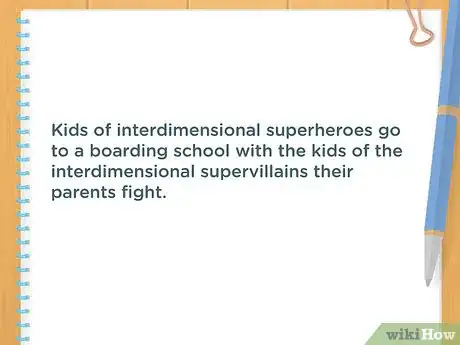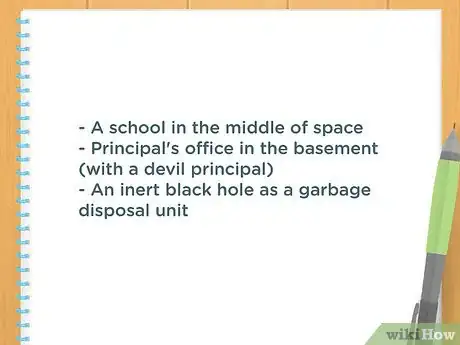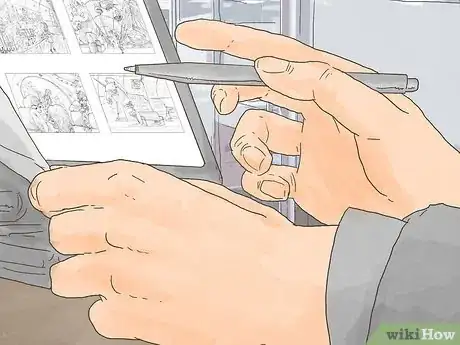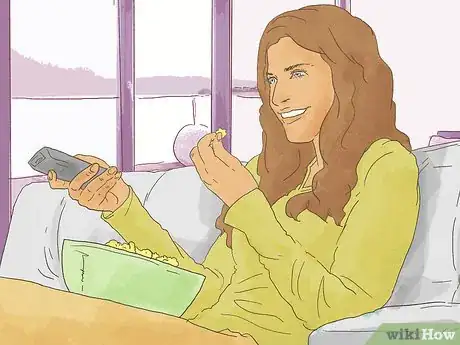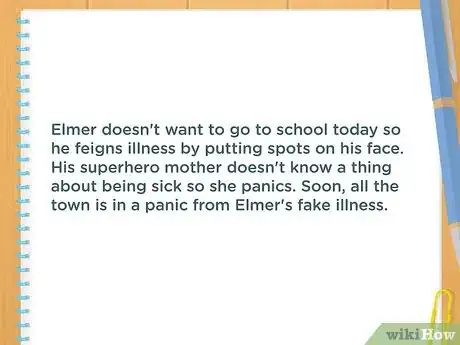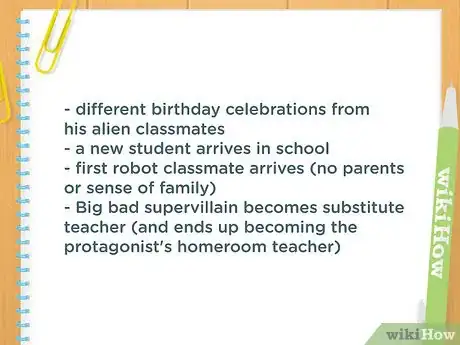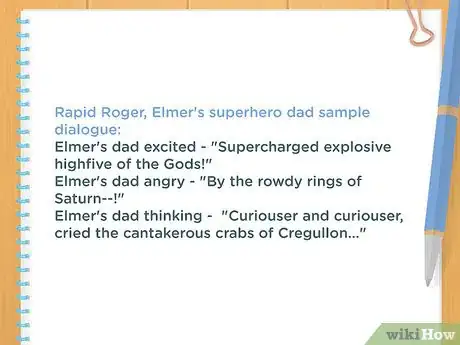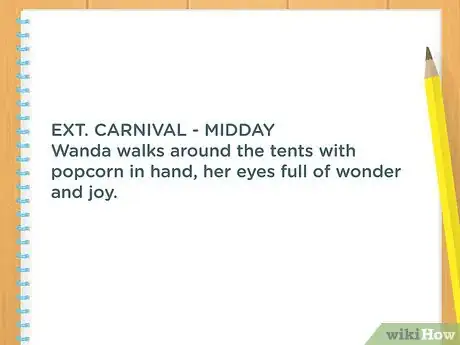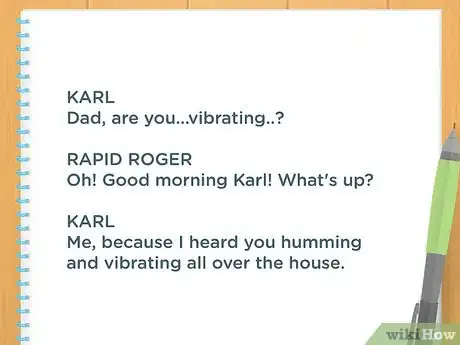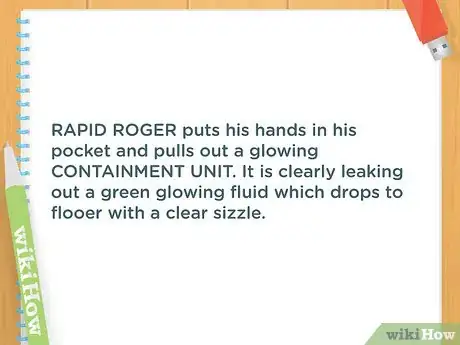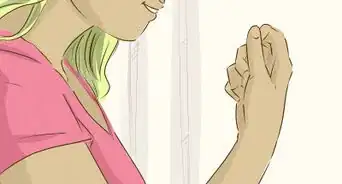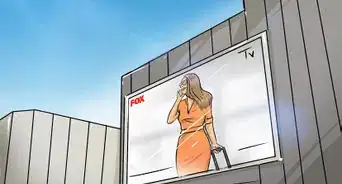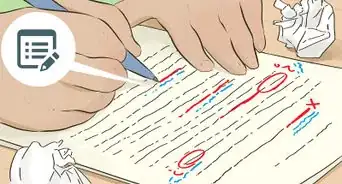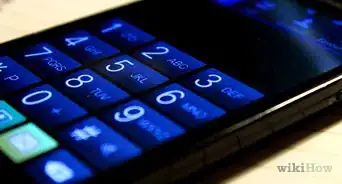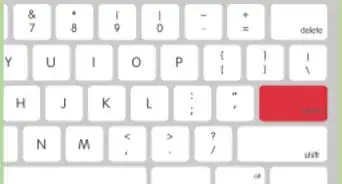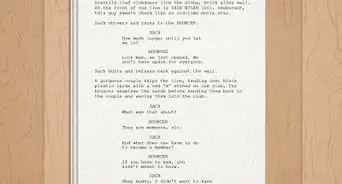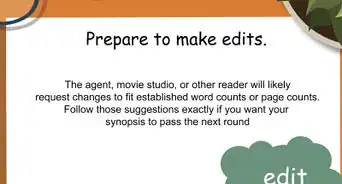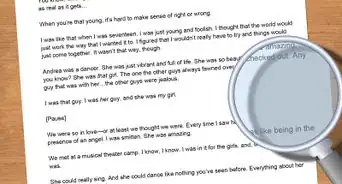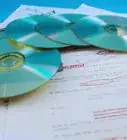This article was co-authored by Melessa Sargent. Melessa Sargent is the President of Scriptwriters Network, a non-profit organization that brings in entertainment professionals to teach the art and business of script writing for TV, features and new media. The Network serves its members by providing educational programming, developing access and opportunity through alliances with industry professionals, and furthering the cause and quality of writing in the entertainment industry. Under Melessa's leadership, SWN has won numbers awards including the Los Angeles Award from 2014 through 2021, and the Innovation & Excellence award in 2020.
wikiHow marks an article as reader-approved once it receives enough positive feedback. This article received 13 testimonials and 83% of readers who voted found it helpful, earning it our reader-approved status.
This article has been viewed 276,975 times.
Animated cartoons are fun to watch and a great challenge to create, as they require creativity, ingenuity, and detail. A successful animated cartoon starts with a good script that fleshes out the characters, setting, and plot of the story. To write a script for an animated cartoon, start by brainstorming unique ideas that take full advantage of the unlimited possibilities of animation. Then, create a draft using the correct [[Write-a-Screenplay|script writing format and language. You should then polish the script so it is ready to be animated and brought to life.
Steps
Brainstorming Your Cartoon
-
1Come up with a unique plot. The beauty of animation is that you can come up with the craziest plot imaginable and have it drawn into life. Embrace the possibilities of animation and create a plot that is unique and imaginative. Avoid familiar plot ideas that you’ve heard before. Challenge yourself to create a plot that puts a unique spin on a familiar idea.[1]
- For example, rather than start with a familiar plot like boy meets girl and tries to get girl, you may go for a plot like boy meets cyborg girl and tries to win her heart by fighting off killer dinosaurs.
-
2Focus on an interesting main character or cast of characters. Create a main character that has distinct characteristics or personality traits. Give your main character a backstory that makes them particular or strange. You may use a real life person as inspiration for your main character or create a main character from scratch.[2]
- For example, maybe you have a main character who is a young girl born with a third eye. Or perhaps you have a main character who is a creature from the swamp, half-man, half-animal.
- You can even have a main character that is not human, such as a walking square or a talking lamp.
- You can also focus your story on a cast of characters, such as an oddball family or a pair of strange siblings.
Advertisement -
3Explore a surreal or strange setting. Make up a setting by combining your hometown with your favorite planet. Or exaggerate a setting, such as your high school, by putting it in a black hole in space. Use the setting as inspiration for your characters and your plot.[3]
- For example, if you decide to use a setting like your high school in space, you may then come up with characters like teenage aliens who go to the high school.
-
4Brainstorm with a partner. Tossing ideas back and forth with a partner may help you generate a stronger story for the animation. Ask a friend, peer, or family member to brainstorm ideas with you. Try yelling out a character idea and then having your writing partner respond with a different idea or add on to it.[4]
- You can also try making a mind map with your writing partner to help generate story ideas.
-
5Create storyboards. Bring your brainstorming ideas to life by drawing storyboards for a few possible scenes in your script. Draw out squares on plain paper and sketch out details like setting, time of day, and scenery for the scene. Include character dialogue and action in the storyboards. See how your ideas work visually in the storyboards.[5]
- Do storyboarding for a few potential plots or characters you are thinking about. You can then tweak your ideas when you sit down to write the draft of the script.
-
6Watch examples of animated cartoons. Get a better sense of the genre by watching cartoons that are considered unique and well-written. Listen to the dialogue of the characters. Notice how the plot in each cartoon moves forward in interesting and unexpected ways. Watch a mix of animated television shows and films. You may watch:
- The Simpsons
- South Park
- Rick and Morty
- BoJack Horseman
- The Powerpuff Girls
- Up
- Steven Universe
- The Amazing World Of Gumball
Creating a Draft
-
1Introduce the main character. Establish your main character in the first scene of the script. Open with dialogue that shows the viewer the character. Place the main character in the setting and have them interact or reflect on the setting. Give the viewer a sense of the main character so they can feel immersed in the story.[6]
- For example, you may open with a scene where your main character goes to work at their job on Mars, showing their daily routine to introduce them to the reader.
- Or you may open with dialogue of a fight between the main character and their partner, showing their complicated relationship.
-
2Include conflict that involves the main character. The conflict can be something the main character wants, but has a difficult time getting due to obstacles or issues. It can also be a conflict between the main character and another character, where neither character can agree or find common ground. The conflict can also come from an outside factor, such as a bad boss, a mean teacher, or a natural disaster.[7]
- For example, you may focus on a simple conflict like the main character doesn’t want to go to school that day. You can then come up with what the main character would do instead if they skipped school, focusing on the weird or strange things they might do.
-
3Keep the setting engaging. Bring the setting to life by including details that make it unique and visually engaging. Make the setting particular by including certain objects in a room. Decide what the climate or weather is in the setting. Include buildings and structures that add to the world of the story.
- For example, you may set your script in a carnival that caters to aliens. You may then include rides that blast the rider to another galaxy or carnival foods that aliens might enjoy.
-
4Write dialogue that explores character and conflict. Dialogue in your script should always be doing two things: exploring character and building conflict. Avoid dialogue like “Hi, how are you?” or “Nice day today.” Write dialogue that cuts to the chase and tells the reader something about the character.[8]
- For example, you may give one character a catchphrase that they say whenever they feel stressed or surprised, such as Homer Simpson's famous "D'oh!"
- You can also have one character with a more casual way of speaking and another character with a more formal way of speaking to create contrast. For example, one character may say, “Sup, alien?” and another character may respond, “Hello there, my illustrious alien friend, how lovely to see you.”
Formatting the Animated Cartoon Script
-
1Note the location and time of day of each scene. This is called the slugline and should appear in ALL CAPS at the beginning of a scene. Use “INT” for an interior location and “EXT” for an exterior location.[9]
- For example, you may write: “EXT. CARNIVAL - MIDDAY” or “INT. LIVING ROOM - NIGHT.”
EXPERT TIPMelessa Sargent is the President of Scriptwriters Network, a non-profit organization that brings in entertainment professionals to teach the art and business of script writing for TV, features and new media. The Network serves its members by providing educational programming, developing access and opportunity through alliances with industry professionals, and furthering the cause and quality of writing in the entertainment industry. Under Melessa's leadership, SWN has won numbers awards including the Los Angeles Award from 2014 through 2021, and the Innovation & Excellence award in 2020.Professional Writer
 Melessa Sargent
Melessa Sargent
Professional WriterThink about the specific details you need to include in the script. Melessa Sargent, the President of Screenwriters Network, says: "Formatting the script for an animated cartoon isn't much different than writing any other kind of script. However, the directions will be a little different, because you'll have to describe the characters, locations, sounds, and things like that."
-
2Format the dialogue for each character. Whenever you use a character name in the script, write it in ALL CAPS. You can then write their dialogue under their name. Center the character’s name and dialogue on the page so it is easy to follow. For example, you may write:[10]
AL THE ALIEN
Come on Mom, let’s ride the Blaster!
MAMA ALIEN
Not a chance on Mars, honey, way too dangerous. -
3Include important objects in the scene. Only list objects that are essential to the scene and not merely to create the background setting. The object may be something the main character sees or touches. It could also be a sign that the character reads, and that should be shown to the viewer as well. Include the object in ALL CAPS in the script.[11]
- For example, you may write: “AL THE ALIEN stumbles over a ROLL OF CARNIVAL TICKETS” or “MAMA ALIEN reads a sign that says “NO MINORS, NO HUMANS.”
-
4Describe the sounds and actions in the scene. Include any sounds in the scene in parentheses and ALL CAPS. For example, you may write, “(CLANKING NOISES)” or “(EXPLODING NOISES).”[12]
- You should also write any actions done by the characters in ALL CAPS and bold. For example, you may write, “She KICKS the human” or “He CRIES into his pillow.”
Polishing the Script
-
1Read the script out loud. Once you have created a draft of the script, read it aloud several times. Notice if it is easy to follow and has a clear conflict. Pay attention to how the dialogue sounds when read aloud. Make sure the dialogue is entertaining and explores character well.[13]
- You should also read the script aloud to check for any spelling, grammar, or punctuation errors.
-
2Ask others to read the dialogue. To hear how the dialogue sounds, ask friends, peers, or family members to play different characters and read the dialogue aloud. This will help you get a better sense of how the dialogue sounds with different voices. Try running through the script at least once to listen to how it sounds.
- In script writing, this is called a “read through.” A read through is often done with the voice actors who are playing the characters to ensure the dialogue sounds right in their voice.
-
3Watch a portion of the script and the animation together. Take one scene and have rough animation done to flesh it out. Then, watch it to confirm the scene is working and the script is effective on a visual level. You can do the animation yourself or hire an animator to bring your script to life.[14]
- If you like the portion that has been animated, you can then get the rest of the script animated. Then, watch the animated cartoon from start to finish to ensure it is to your liking.
Community Q&A
-
QuestionHow can I write a cartoon like "Rick and Morty"?
 Community AnswerDon't try to write a cartoon like "Rick and Morty". Instead, think about the aspects of Rick and Morty you love, ask yourself why you love them, and apply that to an original idea.
Community AnswerDon't try to write a cartoon like "Rick and Morty". Instead, think about the aspects of Rick and Morty you love, ask yourself why you love them, and apply that to an original idea. -
QuestionHow does one come up with funny scenes and/or jokes?
 Community AnswerLook at your own life. What is something funny that's ever happened to you? Maybe you could plant that into the story at some point.
Community AnswerLook at your own life. What is something funny that's ever happened to you? Maybe you could plant that into the story at some point. -
QuestionWhat if I have to make a script out of something that inspires me?
 Community AnswerTo write about something that inspires you, look at your life. Look at your past, present, and speculate about the future. Consider your dreams. Think about the stories, the movies, and friendships that have moved you most, emotionally.
Community AnswerTo write about something that inspires you, look at your life. Look at your past, present, and speculate about the future. Consider your dreams. Think about the stories, the movies, and friendships that have moved you most, emotionally.
References
- ↑ http://chrisoatley.com/animation-pitch-pitfalls/
- ↑ http://chrisoatley.com/animation-pitch-pitfalls/
- ↑ http://www.aestheticamagazine.com/animation-ideas-inspiration/
- ↑ https://www.theverge.com/2015/10/25/9457247/the-simpsons-al-jean-interview
- ↑ https://www.theverge.com/2015/10/25/9457247/the-simpsons-al-jean-interview
- ↑ https://www.bloopanimation.com/story-ideas/
- ↑ https://www.bloopanimation.com/story-ideas/
- ↑ https://www.theverge.com/2015/10/25/9457247/the-simpsons-al-jean-interview
- ↑ https://www.bloopanimation.com/writing-a-script/
About This Article
To write a script for an animated cartoon, start by opening the first scene with dialogue from your main character to immerse the viewers in the story right away. Then, include a conflict that involves the main character, like having them want something that’s hard to get or putting them in a difficult situation with their boss. Additionally, include details about the setting that bring the story to life, such as descriptions of a thunderstorm or a skyscraper. You should also give your characters formal, informal, and other styles of dialogue to reflect their personalities. For tips on how to format your script, read on!
